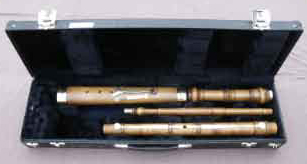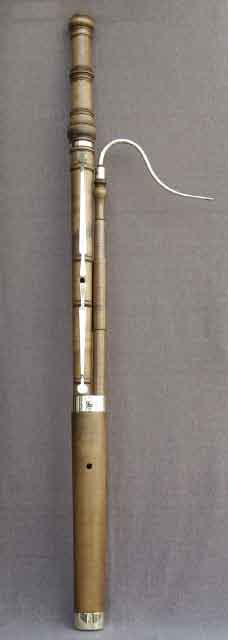The Denner Bassoon
When J C Denner made this bassoon in Nurnburg around the turn
of the 18th Century, he created not only a fine instrument but also one of his
best examples of baroque design and ornate wood turning. He was one of the masters
of his age in creating beauty in the shape and form of his work which went alongside
his constant efforts to improve the instruments he made. 
Although the original instrument had only three keys, this instrument is supplied
as standard with an added G# key. Most other Denner bassoons have the G# key
indicating that they are possibly later instruments. The bassoon can be supplied
without this key if required.
This bassoon is lighter in weight than many of the period and is easy to hold
and play. Players may choose not to use a sling hook at all.
We offer the Denner bassoon at both A=440 and 415Hz
Costs
This instrument is offered at £3850. This
price includes a quality hard case and two reeds.
 Click
image to enlarge
Click
image to enlarge

The instruments are made in short run batches to order. Please
contact us to establish current waiting time for instruments. We do not ask
for any deposit when taking orders and will confirm that you still wish to purchase
the instrument immediatly prior to begining work on the instrument. Should you
wish to cancel the order at that time then this will not be a problem.
Reeds
As with the other bassoons, additional reeds
are available on request. For players who prefer to make their own reeds, the
Rieger B1 reed profile works well with this instrument and allows the full compass
of notes to the top a' to be achieved with ease. Whilst we can supply reeds,
we also recommend the Pro Reeds #364 reed - contact them at www.proreeds.de
 Click
images to enlarge
Click
images to enlarge


Research
In researching and developing this instrument we are indebted to Barbara Stanley
who passed all of her research notes on to us. In addition to this we have experimented
with various bore and crook profiles to bring us to the instrument we sell today.
It is interesting to note that the wing joint on the original instrument has
an unusual, almost parallel, section in the lower half of the wing joint which
has been the subject of conjecture by many researchers over the years. It was
thought that the bore may have shrunk in this region to give the resulting parallel
section and that this was not the original profile of the bore. After making
a number of different wing joints with various bore profiles we can confirm
that a faithful copy of the original bore profile gives by far the best response
in this instrument and we have therefore settled on this for our wing joint.
Our apologies to Mr Denner for ever doubting him!
We have experimented with many crook profiles and have now produced a crook
which matches the instrument and plays freely throughout the full range from
low BB flat to the top a'.
Fingering Chart
We also provide a fingering chart with the instrument. In this chart we have
combined fingering options from a number of original charts from the 18th century
alongside some alternative fingerings suggested by professional players.
As ever with fingerings, they are often a matter of the players individual technique
and reed preference. The chart is offered as a guide, to show the many alternatives
which may be useful.
Click on this key image to
download a copy of our Baroque Bassoon fingering chart




